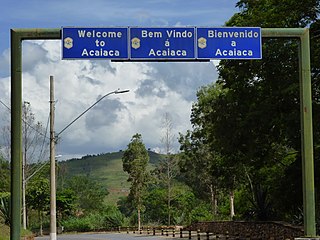Related Research Articles

The Federal University of Rio de Janeiro or University of Brazil is a public research university located in the state of Rio de Janeiro, Brazil. It is the largest federal university in the country and is one of the Brazilian centers of excellence in teaching and research. In terms of scientific, artistic and cultural productions it is recognized nationally and internationally due to the great professors, researchers, reviews and assessments made by international agencies. In 2017 QS World University Rankings ranked UFRJ as the best Brazilian federal university, as well as the third best university in the country occupying the seventh position among institutions of Latin America. In 2016 and 2017 the Ranking Universitário Folha (RUF) ranked UFRJ as the best university in Brazil and the best Federal University in the country. The Center for World University Rankings (CWUR) published in 2017, rated UFRJ as the second best university in the world in the Zoology field.
SOX is a discontinued UNIX clone. It was developed from scratch in Brazil, in the late 1980s, by Computadores e Sistemas Brasileiros S/A, under the leadership of Ivan da Costa Marques. Certified as UNIX-compatible by X/Open in early 1989, SOX was one of the first re-implementations of UNIX, fully independent of AT&T, that passed the X/Open verification tests, and the only one ever completed entirely outside the United States.

Portuguese is the official and national language of Brazil being widely spoken by most of the population. Brazil is the most populous Portuguese-speaking country in the world, with its lands comprising the majority of Portugal’s former colonial holdings in the Americas.
The Prêmio José Reis de Divulgação Científica is an annual honor awarded by the Brazilian Council of Scientific and Technological Development (CNPq) to the institution, media organization, publication, or individual who most contributed to the dissemination and public awareness of science and technology in Brazil. It is thus named in honor of Dr. José Reis, a Brazilian biologist and science writer who was one of the pioneers in the field.
Simon Schwartzman is a Brazilian social scientist. He has published extensively, with many books, book chapters and academic articles in the areas of comparative politics, sociology of science, social policy, and education, with emphasis on Brazil and Latin America. He was the President of the Brazilian Institute for Geography and Statistics (IBGE) and is a retired professor from the Federal University of Minas Gerais. He is member of the Brazilian Academy of Sciences, holder of the Grand Cross of the Brazilian Order of Scientific Merit (1996). He is currently associate researcher at the Institute for Studies in Economic Policy Instituto de Estudos de Política Econômica / Casa das Garças - Rio de Janeiro.

Trem Desportivo Clube, commonly referred to as Trem, is a Brazilian professional club based in Macapá, Amapá founded on 1 January 1947. It competes in the Campeonato Brasileiro Série D, the fourth tier of Brazilian football, as well as in the Campeonato Amapaense, the top flight of the Amapá state football league.

The SBTVD Forum is a non-profit organization of private and public companies responsible for the general aspects of Digital TV deployment in Brazil. The organization was founded in 2007 in order to address all technical issues regarding the upcoming SBTVD standard, also known as ISDB-Tb.

The 14-X is a Brazilian scramjet engine in development by the Aerothermodynamics and Hypersonics Laboratory Henry T. Nagamatsu of the Institute of Advanced Studies (IEAv) of the Department of Aerospace Science and Technology as part of the PropHiper. The name is a reference to the 14-bis, of the Brazilian inventor and aviation pioneer Alberto Santos-Dumont.

Guilherme de Aguiar Camacho, sometimes known as just Camacho, is a Brazilian footballer who plays as a midfielder for Santos.
Claudio Costa Neto is a Brazilian chemical and chemical engineer, one of the founders of the Institute of Chemistry, UFRJ. He is currently emeritus professor at the Institute of Chemistry of the Federal University of Rio de Janeiro.

The Canecão is an indoor arena located in Botafogo, Rio de Janeiro, Brazil. The venue opened in 1967 which was capable of functioning alternatively either as a dance floor or a concert hall. It has been closed since 2010, due to legal quarrels over its ownership.
The Industry Social Service of the State of Rio de Janeiro comprehends SESI's work in Rio de Janeiro state. The institution focuses in improving work environments, quality of life and education levels of collaborators from Rio de Janeiro's enterprises. Through programs and mobile units, it carries out actions related to health, education, sports, leisure, culture, occupational health, work safety and environmental protection. These activities are aimed at workers and companies, as much as to society in general. SENAI Rio's history is parallel to the Brazilian industrial development and its designation accompanies Rio de Janeiro's changes, as when it became a capital and was renamed Guanabara state.
Line 3 of the Rio de Janeiro Metro is a planned line which would connect Rio de Janeiro and Niterói. This is a challenge due to the fact that the line would need to cross the Guanabara Bay, presumably underwater. Niterói last had rail service of any kind in 2007 and its public transit is currently only served by buses and boats.

Patrick de Paula Carreiro, commonly known as Patrick de Paula or simply Patrick, is a Brazilian footballer who plays for Botafogo as a midfielder.

The 2020 Copa do Brasil Finals was the final two-legged tie that decided the 2020 Copa do Brasil, the 32nd season of the Copa do Brasil, Brazil's national cup football tournament organised by the Brazilian Football Confederation.
BB Tecnologia e Serviços (BBTS), formerly Cobra Tecnologia, is a Brazilian information technology company that currently belongs to the Banco do Brasil conglomerate.

14-XS was an Operação Cruzeiro mission conducted by the Brazilian Air Force at the Alcantara Launch Center on December 14, 2021.

The 2022 Copa do Brasil Finals were the final two-legged tie that decided the 2022 Copa do Brasil, the 34th season of the Copa do Brasil, Brazil's national cup football tournament organised by the Brazilian Football Confederation.
References
- ↑ "Brasilien startet Bau der ersten Magnetschwebebahn » latinapress Nachrichten". latina-press.com (in German). 2013-05-24. Retrieved 2022-06-22.
- 1 2 "Trem de levitação magnética abre as portas para o público na UFRJ". O Globo (in Brazilian Portuguese). 2016-02-16. Retrieved 2022-06-22.
- ↑ "Na Olimpíada do Rio, atletas vão usar ônibus ecológico". Agência Brasil (in Brazilian Portuguese). 2016-03-08. Retrieved 2022-06-22.
- 1 2 Globo, Agência O. "Projeto brasileiro de trem de levitação magnética é o primeiro a transportar passageiros com essa tecnologia". Época Negócios (in Brazilian Portuguese). Retrieved 2022-06-22.
- 1 2 "O trem brasileiro que flutua". Revista Galileu. 24 July 2015. Retrieved 22 June 2022.
- ↑ Tecnológica, Site Inovação (2009-06-10). "Começa fabricação do primeiro trem brasileiro de levitação magnética". Site Inovação Tecnológica (in Portuguese). Retrieved 2022-06-22.
- 1 2 "Tecnologia traz segurança e eficiência à mobilidade". G1 (in Brazilian Portuguese). Retrieved 2022-06-22.
- ↑ "G1 > Edição Rio de Janeiro - NOTÍCIAS - UFRJ apresenta protótipo de trem de levitação magnética". g1.globo.com.
- ↑ "Sustainable, low-cost train project is stalled due to lack of investment". g1.globo.com.